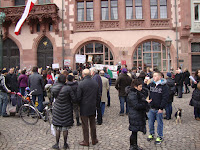Nella
puntata Previous we have seen that integrates Stifel in his Arithmetica
of 1544 unified the various cases of quadratic equations . Stifel's work is, however, passed only after one year of life.
In 1545 it emerged the 'Ars Magna
of
Gerolamo Cardano (1501 -1576) which contained the solutions of the equations of both
third quarter that able . A stunning and unexpected progress to algebra. Enough to bring some historians to consider the
1545 as the year of commencement of the modern period of mathematics . Cardano, however, not
fu lo scopritore né della soluzione delle equazioni di terzo grado né di quella delle equazioni di quarto grado .
Perché fu lui allora il primo a pubblicarle? E a chi andrebbe invece la vera gloria per la scoperta? La storia non è delle più edificanti.
È Cardano stesso ad ammettere nel suo libro che
l'idea gliel'aveva data Niccolò Tartaglia (1499 – 1557) . Nome che a molti di voi evocherà il celebre
Triangolo di Tartaglia . Triangolo che in realtà era
già noto qualche secolo prima , ma che in molti paesi tuttora viene denominato ancora più a sproposito
Triangolo di Pascal .
Ma tornando alle equazioni, dicevamo che Cardano scrisse che l'idea gliel'aveva data Tartaglia. Quello che invece Cardano dimenticò di scrivere è che
Tartaglia gli aveva fatto solennemente promettere di non divulgare il segreto . Quest'ultimo aveva infatti in mente di scrivere un trattato sull'algebra in cui la rivelazione della soluzione delle equazioni di terzo grado sarebbe stata la ciliegina che lo avrebbe coronato come il più grande matematico del tempo.
La vera gloria per la scoperta andrebbe quindi a Tartaglia? Non proprio. Intanto per evitare che Tartaglia venga considerato la povera vittima innocente bisogna ricordare che anche in 1543 he had published a translation of Archimedes others claiming to own. But
to unravel the need to go back a few years back .
And exactly 1526 years to the death of
Scipione del Ferro (1465-1526). It was then that the Iron Age, a professor of mathematics at the University of Bologna,
revealed on his deathbed to his student, Antonio Maria Fior
, the solution of cubic equations of the form x
3 + p x = q . As a side note here one must add that at that time the algebraic notation was a bit 'different that this equation was expressed more or less like this: "
find things cube et equal to a number."
do not know how and when the Iron could discover the solution. He had in fact never wanted to disclose nor publish his discovery. But he had not even revealed that he made a discovery. Perhaps because he planned to publish it only when he found a solution to the equation more general
x 3 x + m + p 2 x = q (
find cube, census et things equal in number ).
However, the voice of revelation began to circulate in the environment of mathematicians and probably reached the ear of Tartaglia. At that point, Tartaglia was probably stimulated to develop his research on the matter. We do not know what this research occurred independently and were based on the ideas of others. The fact is that in 1530 Tartaglia was in possession of a quadratic formula for another type of cubic equations. This time the equations of the form
x 3 x + m 2 = q (
find cube et census equal in number).
Tartaglia speaks with someone, the environment of mathematics is small, and again the voice of the discovery spreads and reaches the ears of Antonio Maria Fior. At that point, Fior, thinking that Tartaglia is an impostor, really wants to challenge him publicly to single combat. This sort of public
duels between men of science were popular at the time .
What was? Each of the other duelists submitted a list of problems to be solved by a certain date. Then, in a time and place fixed, challengers made public possible solutions. The stakes were fame, honor and money. This was one of the reasons why the findings were often jealously guarded.
In our particular case agreements between Fior and Tartaglia require that we provide each opponent thirty issues to be resolved within forty days.
On February 22, 1535 is the date set. The square was packed by a crowd of students, professors, aspiring mathematicians, idle, curious passersby, but also witnesses, judges and notaries. Everyone is waiting for the big challenge. Tartaglia's face, unlike that of Fior, appears serene.
However, when the judge gives the word, Tartaglia speaks with difficulty and stumbling over his tongue Sometimes the words. Why? The facial expression was just a mask worn to hide the nervousness?
We'll find out in the second half ... Previously ... Index Series 






















